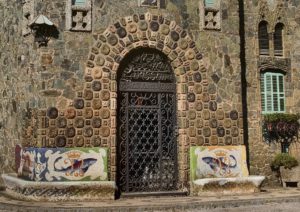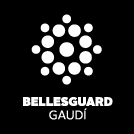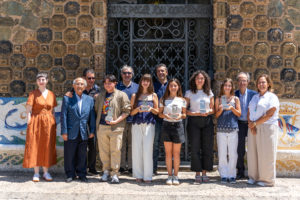January 18, 2024
By: Ferran Garcés

This week, on January 17th, the celebration of Saint Anthony Abbot, the patron saint of animals and farmers, took place. In the past, people brought their livestock to churches to seek protection. Consequently, this occasion has been seized to declare the World Day of Blessing Animals, which this year includes both wild and domestic animals.
So, this week is a good time to start a series of articles about the fauna used to adorn Torre Bellesguard. They form a kind of bestiary, similar to those found in medieval books inspired by allegorical stories of different animals. The first to welcome us are two that live in the sea. Identifying them is not easy. Depending on how you look at them, they could be either dolphins or sharks, but before discussing them, an important clarification is needed.
Clarification of authorship
Torre Bellesguard was built in two stages. The first, from 1900 to 1909, corresponds to Antoni Gaudí. The second, around 1916, to Domènech Sugrañes, one of his closest collaborators. Almost all the animals inside the house and in the garden were created during the stage of this latter architect.
It has not yet been clarified whether Sugrañes carried out the design of these animals based on his own inspiration or following an original idea of Gaudí. What we do know is that both architects were very good friends. In fact, after Gaudí’s death, Sugrañes continued the work on the Sagrada Familia, a building famous for the symbolism of the animals adorning it. On the other hand, the presence of animals in architecture is one of the most characteristic features of modernism (1).

Echoes of a great past…
We leave it to the visitor’s judgment to decide whether the animals on the benches of the main façade of Torre Bellesguard are dolphins or sharks. In any case, they represent the dominance of the Mediterranean during the time of the Casal de Barcelona, the family of Martí I l’Humà, the king who lived in the original palace that inspired Gaudí and Sugrañes. The image is a clear reference to the famous phrase of Roger de Llúria, the admiral of the fleet of Aragon and Sicily (then called Cecilia).
“I do not think that a galley or any other vessel dare to go on the sea without the guidance of the king of Aragon; nor only a galley, nor even a log, but I do not believe that any fish dare to rise on the sea unless it carries a shield or sign of the king of Aragon on its tail, to show the guidance of that noble lord, the king of Aragon and of Cecilia” (Chronicle of Bernat Desclot, Chapter CLXVI).
Currently, Roger de Llúria’s phrase is usually mentioned in a more concise version, stating that no fish will dare to rise in the Mediterranean Sea unless it carries the shield of the king of Aragon on its tail. In any case, on the Bellesguard bench, we find a new element: the letter M formed by yellow ribbons. It seems to allude to Martí I and Margarida de Prades, the queen with whom the monarch married in the ancient Bellesguard palace, or, according to others, to the name of Maria Regina, the Queen Mother, so present in other parts of the building (2).
Next Friday, we will discover more animals from Torre Bellesguard. They are the ones we see in the hall of the house, beyond the door flanked by the fish we have seen today. Animals that evoke again the history of the first inhabitants of Bellesguard, or perhaps once again a symbolism with a religious background, so favored by Gaudí…
Notes
(1) Pons Toujouse, Valentí, “Exotic Animals in Modernist Architecture,” Catalonia Villages website: link
(2) Vall i Composada, Josep M., (2014), “Bellesguard. From the residence of Martí the Humane to Gaudí’s tower,” Duxem, Barcelona, p. 113. Original phrase: “The crowned letter M could have a multiple meaning, both as a tribute to the kings Martí and Margarida, lords of Bellesguard, and, considering Gaudí’s Marian devotion, to Saint Mary the Queen.”
Bergós i Massó, Joan, and Llimargas, Marc (2011) Gaudí. The Man and the Work, p. 150, Lunwerg Editores, Barcelona, p. 150. Original phrase: “Shark intertwined in the Marian M and the four bars, a symbol of Catalan hegemony in the Mediterranean.”
Also, see on our blog: The Immaculate at Bellesguard




